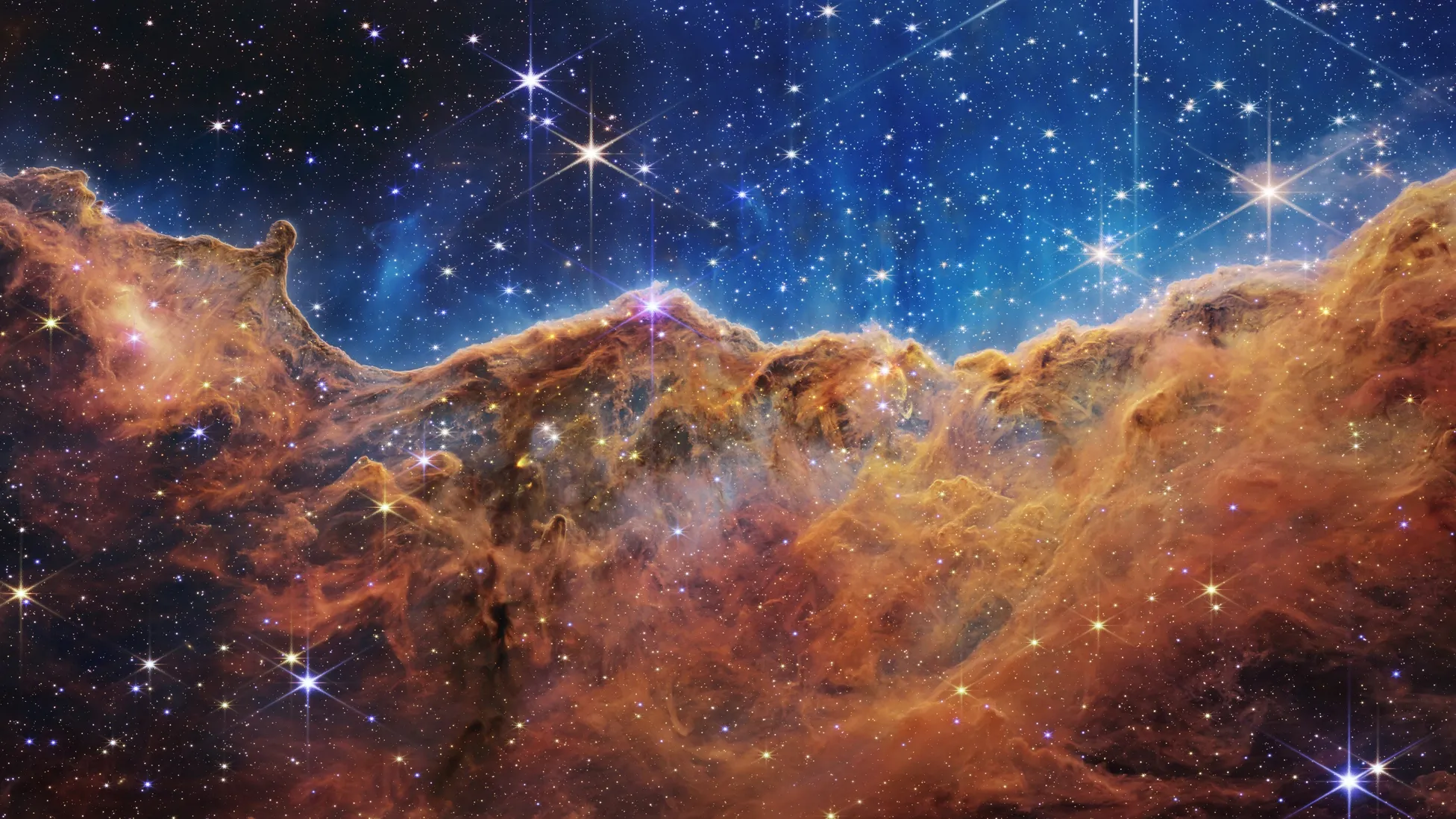A 13-Billion-Year-Old Perspective On Things
The James Webb Space Telescope reminds us that our problems don’t amount to a hill of beans in this crazy, glorious universe. For that matter, neither do we.

On June 3, 1965, Ed White became the first American to walk in space, during the Gemini 4 mission. The photos of his space walk seemed almost magically cool and serene to Americans during that hot summer of antiwar protests and race riots.


I was ten years old and, once I found out that Ed White had been born and raised in San Antonio, my future was clear to me: I would become an astronaut.
A magazine published pictures of the inside of a Gemini spacecraft, including the layout of the instrument panel, which looked something like this:

I took a big piece of cardboard, covered it with white butcher paper, then painstakingly copied the cockpit configuration to the butcher paper until I had a reasonable, but much bigger, facsimile of it. Then I suspended the cardboard from the ceiling of my bedroom at just the right height so that, lying on my back on a kitchen chair repurposed as an astronaut seat, I could fly a Gemini spacecraft into the cold mysterious vastness of space.
Because a couple kitchen chairs were requisitioned for the space program (and believe me, they were probably more comfortable than the early spacecraft seats), my sisters were not happy about my interference with their ability to eat their peanut butter and jelly sandwiches in peace. In my enthusiasm, I offered to let them sit in the capsule and to show them how you could eat a PB&J sandwich in the weightless environment of deep space. For reasons I still do not understand, they did not take me up on my offer.
Eventually, my enthusiasm for being an astronaut waned. I think I decided next to be Sherlock Holmes, whose phenomenal powers of observation and detection were solidly earthbound. So earthbound, in fact, that he was unaware that the earth revolved around the sun. When Watson remonstrates with him, Holmes snaps irritably:
“What the deuce is it to me? You say that we go round the sun. If we went round the moon it would not make a pennyworth of difference to me or to my work.”
Nevertheless, I remained an enthusiastic fan of the space program. I mourned Ed White when he perished in the Apollo 1 fire. I rejoiced as Neil Armstrong stepped onto the moon on July 20, 1969, my delirium only enhanced by eating Mama Mireles’s tacos. It was one small step for a man, one large taco for a 14 year-old boy.
As I grew older, I remained enthralled by the heavens and their glorious raiment. For several years in my 20s, I was a counselor at a summer youth camp. The camp was located on a fork of the Guadalupe River, and there was a dock that stretched from the shore into the middle of the river course. I had a National Geographic star map which, if placed under a fluorescent light for 30 minutes, would glow sufficiently for it to be read in the dark for maybe 20 minutes. Stargazing thus necessitated shuttling from the dock to the fluorescent light, then back out under the dome of heaven in the middle of the Guadalupe. Thus were many nights spent.
In this manner, I became familiar with the magnificent starscape of the summer sky in Texas: the Milky Way, of course, and so many of the constellations: the Big and Little Dippers, the Northern Cross, magnificent Scorpio which dominates the summer sky at this latitude, and many others – Lyra, King Cepheus and his vain wife Cassiopeia, their daughter Andromeda, and more. If we stayed up late enough, we’d see the Great Square of Pegasus rising and there, near one leg of the mighty beast, we’d see the Andromeda galaxy, barely visible to the naked eye.
Studying these constellations whetted our appetite for the Greek myths about them, and my enterprising friend Bruce contrived to check out a copy of Bullfinch’s Mythology from the Kerrville library. Thus armed, we would study constellations patterns at night and, in the light of day, read tales of bravery, romance and derring-do from Greek heroes and heroines of olden times. We even developed a little presentation of sorts, pointing out a carefully curated set of constellations to the young campers in our charge and regaling them with tales of proud gods and foolish humans, and bravery, and love.
Life goes on, but the stars above remain constant. I celebrated the Hubble Space Telescope’s launch in 1990, marveling at our ability to overcome thousands of technical problems, and gravity itself, to put a telescope above the Earth and peer deeper into the cosmos than we ever had. The images were astounding, pictures of stars and galaxies and nebulae that had only been glimpsed dimly, if at all. Now we saw them, and they were more beautiful than we could imagine.
NASA and its partner, the European Space Agency, kept the pictures coming. Hubble has now celebrated its 30th birthday and is still going strong. NASA scientists think it might remain functional until sometime between 2028 and 2040 when its orbit will degrade enough for it to re-enter the atmosphere.
Even as we celebrated Hubble’s unprecedented achievements, the scientists were figuring out how to look higher and further, to stretch the boundaries of what we could see and, in so doing, to widen our minds and our understanding.
And so, on Christmas Day, 2021, the James Webb Space Telescope lifted off from the European spaceport at Kourou, French Guiana, on its way to a point one million miles above the Earth. Webb reached its orbit in late January, then began a series of maneuvers to settle into the orbit and to fine-tune the focus of the observatory’s instruments. Finally, last week, Webb’s first images – baby pictures, if you will — were released to the public and once again we were rendered speechless by what we saw.
I talked with my friend Danny tonight, who is an amateur astronomer and photographer. In fact, he has turned the Marathon Motel and RV Park, which he owns, into a sky park of some international renown.
We ended up talking about the JWST images, especially the deep field picture of the SMACS 0723 galaxy cluster:

This is a stunning image, but don’t go out in the backyard to look for it: this is an area of the sky the size of a grain of sand held at the end of your arm. The light from the cluster at the center of the photo is 4.6 billion years old – about the age of our solar system. Put another way, the light we’re seeing left SMACS 0723 about the time our sun started to cool into a star. The galactic mass of SMACS 0723 is so dense that it bends and magnifies the light coming from behind it, which is as old as 13 billion years; hence, the “deep field.” Such images have light from some of the first galaxies to come into existence and are visible at extraordinary sharpness and clarity to JWST.
Neither Danny nor I have formal training in astronomy, but we both were awestruck by that image and what it told us about our world. We’re just two guys, staring up at the night skies with their lovely panoply of stars silently wheeling overhead, and wondering. We are among millions of earthlings gaining a new respect for our place in the universe.
And that is the point: The Hubble and James Webb telescopes are truly miraculous. They will increase our understanding of the universe we live in immeasurably, and not just for fancy-schmancy astrophysicists. They represent scientific and technological achievements of the highest order, and also represent increasingly rare triumphs of collaboration and problem-solving in the political and governmental realm. Each telescope’s design, development, testing, launch and placement into the heavens took at least 20 years. They involved partnerships with other space agencies – the European Space Agency (ESA) in the case of the Hubble, and the ESA and the Canadian Space Agency (CSA) in the case of the JWST. In the end, thousands of scientists, engineers, and manufacturers contributed to the projects’ success.
And there’s more to come. Five more space telescopes, each superior to Hubble or JWST in some way, are in some stage of design or construction.
The entire enterprise is driven by two imperatives – to do something spectacular, and to get it absolutely, dead solid perfect right. Their existence is a tribute to our ability to look beyond ourselves and the narrow spatial-temporal environment we live in and contemplate our place in the bigger universe. Even while we continue to foul the spatial-temporal environment we live in.
Seriously, how many things can we say that about?
So, the next time you despair of the deep cynicism, abundant mendacity and cruel self-centeredness of our times, take a moment to check out the JWST and Hubble websites, particularly their image galleries. Take comfort in the fact that no matter what crisis thrills, terrifies or enrages you today, the universe has managed to survive for 13+ billion years without you and will likely go on once you are gone.
Then get back to work on making our world better.
